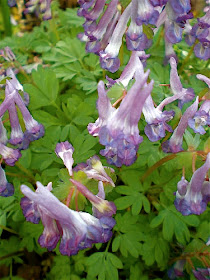Saruma henryi May 2009
Trillium luteum May 2009
Primula elatior March 2010
Heuchera americana 'Green Spice' April 2010
Brunnera macrophylla 'Jack Frost' 0609
Corydalis cava March 2010
Hacquetia epipactis March 2010
Here is a list of shade perennials for gardens in Seattle, the Pacific Northwest & USDA Zone 8. They provide a range of color, height & texture. Bloom starts early in spring & lasts until summer. But shade perennials are often prized for their beautiful foliage, instead of their flowers. You will need to keep snails & slugs from disfiguring the large leaves of some of these perennials. Gather them in a paper bag & toss it into the yard waste bin. A perennial is any plant, not woody, that lives for at least a few years, although some are short-lived. Perennials include bulbs, ferns & grasses. Perennial groundcovers are listed in Groundcovers for Shade. Don't allow shade perennials to dry out completely in summer. Some of these tolerate some dryness, as noted. But most prefer a moist environment. If your garden is dry, read Dry Shade. Many of these perennials are common in gardens. But it may take dedicated searching to find sources for all of them. Although this list is not complete, it is fairly broad. A single common name is noted when the plant has a common name. While some have several common names, others have none at all. Latin names will be most useful to you in finding uncommon plants. An excellent reference book for perennials is Perennials: The Definite Reference With Over 2,500 Photographs by Roger Phillips & Martyn Rix.
Aconitum (Monkshood): many species
Actaea pachypoda (Doll's Eyes) Actaea rubra (Red Baneberry): berries highly poisonous
Adiantum pedatum (Maidenhair Fern)
Alchemilla mollis (Lady's Mantle): for part shade, tolerates dryness
Anemone x hybrida (Japanese Anemone): tolerates dryness, spreads widely by stolons, Anemone nemorosa (Wood Anemone) Anemone sylvestris (Wood Anemone): spreads widely by stolons
Athyrium niponicum ‘Pictum’ (Japanese Painted Fern)
Achlys triphylla (Vanilla Leaf): tolerates some dryness
Astilbe (Ostrich Plume): several species & cultivars
Bergenia (Elephant Ears)
Blechnum spicant (Deer Fern): tolerates some dryness
Brunnera macrophylla 'Jack Frost' (Bugloss)
Campanula latifolia, Campanula takesimana (Bellflower)
Cimicifuga (Bugbane)
Clintonia uniflora (Queen's Cup): & other species
Darmera peltata (Indian Rhubarb)
Deinanthe bifida, Deinanthe caerulea (Deinanthe)
Dicentra cucullaria (Dutchman's Breeches) Dicentra eximia (Fringed Bleeding Heart) Dicentra spectabilis (Bleeding Heart, renamed Lamprocapnos spectabilis)
Diphylleia cymosa (Umbrella Leaf)
Digitalis purpurea (Foxglove): short-lived, but returns from seed
Doronicum (Leopard's Bane): several species for part shade
Dryopteris erythrosora (Autumn Fern): tolerates some dryness
Eomecon chionantha (Snow Poppy)
Epimedium (Bishop’s Hat): many species
Erythronium dens-canis (Dog-tooth Violet) Erythronium oregonum (Fawn Lily)
Euphorbia amygdaloides ‘Purpurea’ (Wood Spurge)
Gaultheria procumbens (Wintergreen)
Geranium 'Johnson's Blue' (Cranesbill) Geranium phaeum (Mourning Widow)
Glaucidium palmatum (Japanese Wood Poppy)
Hacquetia epipactis (Hacquetia): tolerates some dryness
Hakonechloa macra 'Aureola' (Japanese Forest Grass): & other cultivars
Helleborus argutifolius (Corsican Hellebore): part shade, Helleborus x hybridus (Lenten Rose) Helleborus lividus, Helleborus x sternii (H argutifolius x H lividus): all tolerate dryness
Hepatica americana (Liverwort)
Heuchera americana: many cultivars, Heuchera micrantha 'Palace Purple' (Alumroot)
Hosta (Plantain Lily): many species & cultivars
Ligularia (Leopard Plant): many species
Liriope muscari (Lily Turf): tolerates dryness
Luzula sylvatica (Wood Rush)
Lysichiton americanus (Skunk Cabbage): for wet places
Meconopsis betonicifolia (Blue Himalayan Poppy): & other species
Milium effusum 'Aureum' (Golden Wood Millet)
Mitella breweri, Mitella diphylla (Miterwort)
Omphalodes cappadocica (Navelwort)
Petasites japonicus, Petasites palmatus (Coltsfoot): spreads widely by rhizomes
Podophyllum hexandrum, Podophyllum peltatum (May Apple)
Polygonatum odoratum (Solomon’s Seal): & other species
Polystichum munitum (Western Sword Fern): tolerates dryness, Polystichum polyblepharum (Tassel Fern) Polystichum setiferum (Soft Shield Fern)
Primula (Primrose): many species & cultivars
Pulmonaria (Lungwort): many cultivars
Rodgersia podophylla (Rodgersia): & other species
Saruma henryi (Saruma)
Smilacina racemosa (False Solomon’s Seal): tolerates some dryness
Tellima grandiflora (Fringecup): tolerates some dryness
Thalictrum aquilegifolium (Meadow Rue): for light shade
Tiarella wherryi (Foam Flower)
Tolmiea menziesii (Piggyback Plant)
Tricyrtis (Toad Lily): several species & cultivars
Triosteum pinnatifidum (White Feverwort): tolerates some dryness
Trillium (Wake Robin, Toad Shade): many species
Uvularia grandiflora (Merry Bells)
Viola sempervirens (Pioneer Violet)















